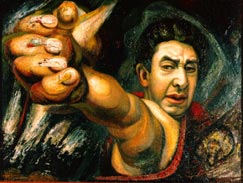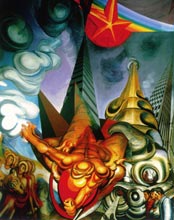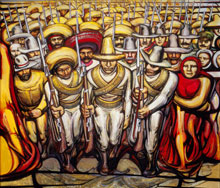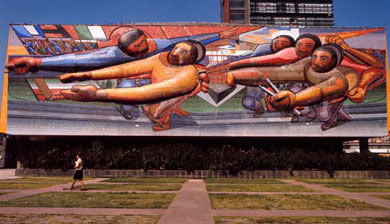 |
 |
|
David Alfaro Siqueiros was an outspoken artist and agitator for social and
political change in twentieth-century Mexico. He believed that true art must
be a public statement, especially in the form of the murals that represented
the indigenous people of his country and their struggle for justice. He worked
relentlessly throughout his life for this ideal through his art, his written
treatises, and his speeches.
|
|
David Alfaro Siqueiros, Self
Portrait (El Coronelazo), 1945 |
|
|
Born in 1896 in Chihuahua,
Mexico, to a bourgeois family, Siqueiros went to Mexico City as a teenager
to study art and architecture. The year was 1910, the beginning of the Mexican
Revolution. He became immediately involved in student strikes and at
age 18 joined the Mexican Revolutionary Army. He later joined the Communist
Party and was both jailed and exiled from Mexico several times for his radical
views and his harsh criticism of the Mexican government. Even so, the government
commissioned large-scale murals by Siqueiros and his fellow muralists, Diego
Rivera and José Clemente
Orozco, who shared his revolutionary outlook.

David Alfaro Siqueiros, For
the Complete Safety of all Mexicans at Work (detail), 1952–54 |
 |

David Alfaro Siqueiros, From the Dictatorship of Porfirio Diaz to the Revolution—The People in Arms (detail), 1957–65 |
Siqueiros worked in the United States in the 1930s. In Los Angeles, he painted a mural depicting the domination of Latin America by the United States and another one so controversial he was threatened with deportation. He traveled to South America to make murals, returning to New York City in 1936. He opened an experimental
workshop where young artists—including Jackson Pollock—dripped and splattered commercial paint to make art.
In 1937, Siqueiros joined the Spanish Republican Army and fought against fascist
forces in the Spanish Civil War. The Army's defeat and the rise of fascism
would become important subjects of his art; for example, Siqueiros' murals
at the Palace of Fine Arts, the Chapultapec Castle, and the National University
in Mexico City, among others.
Rejecting traditional methods of fresco painting, Siqueiros is responsible for several technical innovations. He developed a method of direct painting with quick-drying, industrial materials and spray guns on cement. He also used escultopintera, a combination of sculpting and painting, in several of his works.
Siqueiros died in 1977, his revolutionary murals and writings securing his place in both the history of Mexico and the history of art.

David Alfaro Siqueiros, The
People for the University. The University for the People.,
1952–56
|



